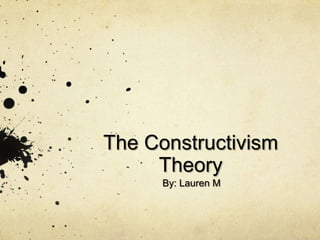
Lauren McGinnis Constructivism
- 1. The Constructivism Theory By: Lauren M
- 2. Constructivism Constructivism is based on a type of learning in which the learner forms, or constructs, much of what he or she learns or comprehends. Confucius once said, “I hear and I forget. I see and I remember. I do and I understand.” The constructivism theory abides by this quote, believing that students should actively participate in critical thinking and analyzing the problem to construct and create the problem so they can translate what they just learned. Confucius
- 3. Discovery Learning Discovery learning is a branch of constructivism developed by Jerome Bruner that incorporates the learner to draw on past experiences and previous knowledge to discover new facts, profound relationships, and inexperienced truths. This constructivism learning theory proves to be beneficial since students can remember concepts and knowledge that they discovered all on their own. Jerome Bruner
- 4. Key Influential Figures In Constructivism Jean Piaget- developed four cognitive stages that showed how children construct new knowledge as they moved through different schemas by building on what they already knew. Jerome Bruner- Believed that constructivist learners are participatory learners. Therefore his theory incorporated the theoretical concept of cognition which states that a individual progresses through different learning stages. He states that teachers should practice the Socratic method by starting discussions in class to build upon questions and answers for the students to think critically. In addition, Bruner felt that the curriculum should be spiral, meaning the students will continually build upon information they have already learned. Jean Piaget
- 5. Key Influential Figures In Constructivism Lev Vygotsky- created social cognition learning which asserts that culture is the prime determinant of a child’s social development. He proposed the zone of proximal development, collaborative learning, scaffolding, and anchored instruction (technology based learning where students build on what they already know). John Dewey- was apart of the progressive education movement which focused on educating the whole entire body of a child, socially, mentally, and physically. Dewey was known as a pragmatist, who only believed the truth of theories if the theory actually worked. John Dewey
- 6. Classroom Implications What the teacher does under this theory: Without technology, teachers should allow students to construct, create, and actively inquire the lesson into an activity to learn the information. Teachers should encourage their students to discover concepts by themselves by engaging them to create opportunities for discussion. With technology, teachers should motivate the students to explore different outputs of technology. They should allow students to approach different types of technology such as usage of the internet, word processing programs, or electronic flashcards. They can use Web Quests, scavenger and treasure hunts, curriculum pages, and other educational technologies as well to help there students.
- 7. Classroom Implications What the students do under this theory: Without technology, students should participate in the Socratic method, explore the curriculum, conduct science experiments, and use manipulatives for math. With technology, students have many different learning strategies that technology offers. They can research certain topics using videos, web sites, digital media outputs, creating spreadsheets, writing essays in word processing documents. All of these methods contribute to the students a constructivist learning approach.
- 8. My Opinion For my own teaching I believe this method would be very beneficial in a classroom. It challenges a child to search for information through personal experience and reflect back on previous knowledge to find the answer. As a teacher, the constructivism theory will help discover the level of each child’s cognitive and social development, therefore I’ll know where they stand and how to build on there learning experiences and styles. Incorporating this teaching style into a classroom will help translate the information into an appropriate forms of learning methods in order for the students to understand. This theory is a more hands on approach, allowing the students to build new information off of there previous knowledge. Therefore the students can grow and learn new information which they’ll retain and remember for a longer period of time.
- 9. Credits http://www.learning-theories.com/ “Integrating Technology and Digital Media in the Classroom”Sixth Edition. Our classroom textbook.